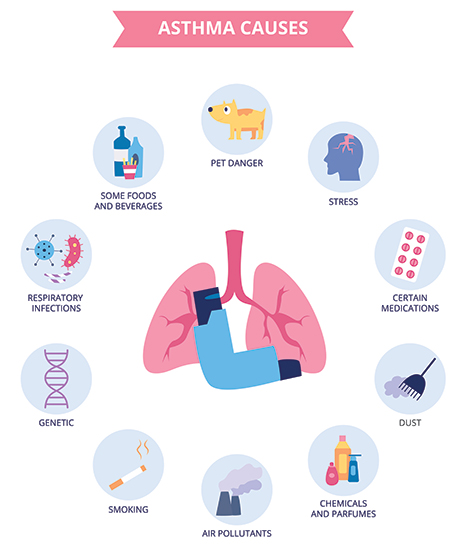Long-term air pollution exposure triggers allergic immune responses in the lungs – News-Medical

Report on the Immunological Impact of Air Pollution and its Relation to Sustainable Development Goals
Introduction: A Global Health Crisis Impeding Sustainable Development
Air pollution represents a significant barrier to achieving the United Nations Sustainable Development Goals (SDGs), particularly SDG 3 (Good Health and Well-being). With over 90% of the global population exposed to air quality below World Health Organization safety standards, the health repercussions are extensive. This report details recent scientific findings that elucidate the molecular mechanisms through which air pollutants compromise respiratory health, reinforcing the urgent need for action under SDG 11 (Sustainable Cities and Communities) and SDG 13 (Climate Action).
Research on Particulate Matter and Pulmonary Immune Response
Study Overview
A study conducted by researchers at Pusan National University School of Medicine, South Korea, investigated the long-term effects of particulate matter (PM) on the pulmonary immune system. The research, published in Redox Biology, aimed to clarify how chronic exposure to PM10 and PM2.5 disrupts immune balance, a critical knowledge gap in understanding pollution-related diseases. This work directly contributes to the evidence base needed to inform policies for SDG 3 and SDG 11.
Methodology and Key Findings
The research team utilized a mouse model to simulate chronic human exposure to air pollution. Mice were exposed to PM10 and PM2.5 over a 16-week period. Subsequent analysis of lung tissue and immune cell profiles yielded several critical findings:
- Pulmonary Inflammation: Exposed mice exhibited significant lung damage, including alveolar wall thickening, infiltration of immune cells, and tissue scarring. These effects were more pronounced in the PM2.5 group, aligning with its ability to penetrate deeper into the lungs.
- Immune System Imbalance: A notable shift in the immune response was observed. The protective TH1-type immune response was suppressed, while the TH2-associated allergic response was amplified.
- Biomarker Elevation: Levels of key indicators associated with allergic inflammation and asthma, such as cytokines (IL-4, IL-5, IL-13) and antibodies (IgE, IgG1), were significantly elevated.
- Activation of the NRF2 Pathway: The study identified a mechanistic link between PM exposure and the activation of the NRF2 pathway, a primary regulator of oxidative stress. While typically protective, chronic activation of NRF2 was found to drive the harmful TH2 immune shift.
Implications for Achieving the Sustainable Development Goals
Advancing SDG 3: Good Health and Well-being
The study’s findings are paramount for advancing SDG Target 3.9, which aims to substantially reduce deaths and illnesses from air pollution. By identifying the NRF2 pathway as a key driver of pollution-induced allergic inflammation, the research opens new avenues for therapeutic intervention.
- Potential treatments could include antioxidants or drugs that modulate NRF2 activity.
- This provides a scientific basis for developing strategies to prevent or treat conditions like asthma exacerbated by poor air quality.
Supporting SDG 11: Sustainable Cities and Communities
This research provides compelling scientific evidence for policymakers working towards SDG Target 11.6, which focuses on reducing the adverse environmental impact of cities by improving air quality.
- The clear link between PM exposure and severe immunological damage underscores the necessity of implementing and enforcing stricter air quality regulations.
- Protecting vulnerable populations within urban environments from the molecular-level harm caused by pollution is essential for creating safe, resilient, and sustainable communities.
Conclusion: An Integrated Approach to Health and Environment
This research provides a crucial understanding of how air pollution compromises the human immune system at a molecular level. The identification of the NRF2 pathway’s role in promoting allergic-type inflammation offers a tangible target for future medical treatments. Ultimately, these findings reinforce the interconnectedness of the SDGs, demonstrating that protecting public health (SDG 3) is inseparable from creating sustainable urban environments (SDG 11) and taking action on climate (SDG 13). The report concludes that addressing air pollution through robust regulatory action is a fundamental requirement for achieving global sustainable development.
1. SDGs Addressed or Connected
-
SDG 3: Good Health and Well-being
This is the most prominent SDG in the article. The entire text focuses on the adverse health effects of air pollution. It explicitly states that “Air pollution is a global health concern” and details how particulate matter causes “lung inflammation,” “tissue scarring,” and can “worsen asthma and other allergic diseases.” The research aims to understand these health impacts to find new treatments, directly contributing to the goal of ensuring healthy lives.
-
SDG 11: Sustainable Cities and Communities
The article addresses the core issue of urban environmental quality. Air pollution from particulate matter (PM2.5 and PM10) is a major challenge in cities worldwide. The concluding statement that the research “supports the need for stronger air quality regulations to protect vulnerable populations” directly relates to making human settlements safer and more sustainable by managing air quality.
2. Specific Targets Identified
-
SDG 3: Good Health and Well-being
-
Target 3.9: By 2030, substantially reduce the number of deaths and illnesses from hazardous chemicals and air, water and soil pollution and contamination.
The article directly addresses this target by investigating illnesses caused by air pollution. The research explores how “chronic exposure to particulate matter (PM10 and PM2.5) triggers harmful allergic-like (TH2) immune responses in the lungs,” leading to conditions like “asthma and other allergic diseases.” The study’s purpose is to understand and ultimately prevent or treat these pollution-induced illnesses.
-
-
SDG 11: Sustainable Cities and Communities
-
Target 11.6: By 2030, reduce the adverse per capita environmental impact of cities, including by paying special attention to air quality and municipal and other waste management.
This target is relevant because the article focuses on the negative impacts of poor air quality, a key aspect of the urban environment. The study’s findings on the dangers of “PM10 and PM2.5” reinforce the urgency of this target. The call for “stronger air quality regulations” is a direct recommendation for actions needed to achieve this target.
-
3. Indicators Mentioned or Implied
-
For Target 3.9
-
Indicator 3.9.1: Mortality rate attributed to household and ambient air pollution.
While the article does not provide specific mortality statistics, it strongly implies the severity of health outcomes that contribute to this indicator. It describes air pollution as a “global health concern” and details physiological damage such as “alveolar wall thickening, immune cell infiltration, and tissue scarring,” which are precursors to severe illness and potential mortality.
-
-
For Target 11.6
-
Indicator 11.6.2: Annual mean levels of fine particulate matter (e.g. PM2.5 and PM10) in cities (population weighted).
This indicator is directly mentioned and central to the article’s premise. The research is based on the effects of “particulate matter (PM10 and PM2.5).” The article provides a clear measure of the problem by stating that “over 90% of the world’s population breathing air that exceeds World Health Organization safety standards,” which is a direct reference to measuring particulate matter levels against a benchmark.
-
4. Summary Table: SDGs, Targets, and Indicators
| SDGs | Targets | Indicators |
|---|---|---|
| SDG 3: Good Health and Well-being | 3.9: Substantially reduce the number of deaths and illnesses from hazardous chemicals and air, water and soil pollution and contamination. | 3.9.1: (Implied) Mortality rate attributed to household and ambient air pollution, referenced through discussion of severe illnesses like asthma and lung inflammation. |
| SDG 11: Sustainable Cities and Communities | 11.6: Reduce the adverse per capita environmental impact of cities, including by paying special attention to air quality. | 11.6.2: (Mentioned) Annual mean levels of fine particulate matter (e.g. PM2.5 and PM10), as the article focuses on these specific pollutants and notes that air quality exceeds WHO safety standards for most of the world. |
Source: news-medical.net

What is Your Reaction?
 Like
0
Like
0
 Dislike
0
Dislike
0
 Love
0
Love
0
 Funny
0
Funny
0
 Angry
0
Angry
0
 Sad
0
Sad
0
 Wow
0
Wow
0













































































